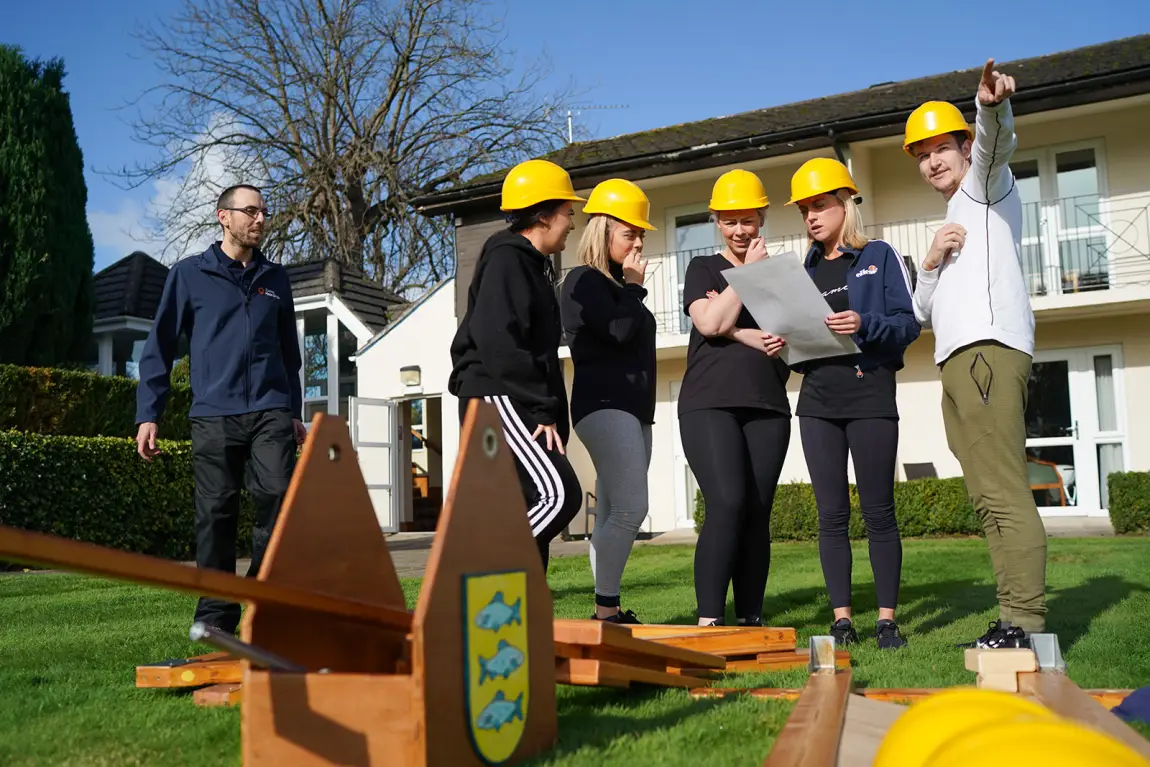
Team cohesion should be the goal for any people manager wanting to achieve high performance and smash their targets. Without a cohesive team, business goals can be difficult or even impossible to reach.
But what constitutes a cohesive team, how do you identify cohesion and what can you do to achieve it? Events Made Simple can help by facilitating quality team building activities to inspire cohesion within your team.
Team or group cohesion describes the ability of a team to work as a single effective machine (or organism, if you prefer), to achieve a common goal. It reflects the interpersonal bonds and connections between team members.
Cohesive teams understand each other, appreciate each other's skills, and make use of their combined strengths to mitigate individual weaknesses.
A cohesive team creates a happy workplace, a sense of belonging, and is typically composed of supportive and positive relationships. They are normally motivated by group success and celebrate team goals over individual success and ‘one-upmanship’, while still apprectaiting each others efforts and abilities
A successful team is always more than the sum of its parts.
While the definition of team cohesion describes a wonderful world of achievements and rainbows, getting there is hard. Gaining employee engagement and buy-in takes time and effort.
The foundation of a cohesive team comes initially from leadership. The team manager is an integral part of building team cohesion, but can’t force a team to be cohesive. A good manager will provide opportunities for team cohesion to occur ‘naturally’.
A manager's ability to understand the nuances of their team members is essential to forming a cohesive team. A one-size-fits-all approach doesn’t work, and neither will a 'Marmite manager' win the hearts and minds of their team members.
Your role as team leader is to pull together the different cultures, learning styles, and personalities that inevitably make up a team. Then, taking the time to build trust and relationships with your team members, both individually and as a whole.
These are the manager's foundation stones of team cohesion.
A good tip for leaders is to ‘go last’ in meetings. In a hierarchy, junior staff often feel decisions are already made. They feel their suggestions are pointless. By introducing a topic and letting everyone speak before you, it demonstrates that everyone's opinion is valid and heard.
Communication is key, as in so many areas of life. Establish clear and open communication about your goals. Clarify shared expectations and norms.
Good communication doesn’t just happen. You need to put effort into it.
It involves listening to people, making them feel heard, and always providing support when they ask for help.
Allow people to communicate in their own way. Some people need time for reflection and assessment before speaking up.
It's also important to repeat verbal communication in writing.
Memory can be fickle, and stress, tiredness, and the distractions of modern life can cause someone to miss an important point. You’ll have people on your team who process information in different ways and at different speeds, as well as those who might be sick or on holiday.
A written record ensures that no-one misses out on vital news or decsions.
Make sure to distribute meeting agendas in advance so that people can prepare. Write summaries of team agreements and meetings so that everyone knows what the team agreed upon, said, and requested.
To work towards a goal, it's necessary for everyone to understand what the goal is and how they can contribute to its achievement.
Clear, measurable, and achievable team key performance indicators can embed a sense of team spirit with staff working together to maximise their performance.
Feedback and recognition when targets are achieved can positively impact your team's motivation.
So, where are your team right now, and how do they achieve cohesion?
Psychologist Bruce Tuckman described the process of team cohesion as comprising four (or five*) distinct stages of development. Tuckman postulates that a team must progress through these stages of development to become fully cohesive in the fourth ‘performing’ stage.
Tuckman labelled the four stages of team development as ‘forming’, ‘storming’, ‘norming’, and ‘performing’.
1. Forming:
The first stage involves team members getting to know each other and understanding the team's goals.
It's often characterised by politeness and a lack of clear direction. People might defer to each other more, and more reserved individuals may stay around the edges of the group. People may feel anxious, excited or curious. They will be looking to the leader for direction.
This stage lasts for a while as people get to know each other and their individual ways of working.
2. Storming:
As team members start to work together, conflicts and competition may arise.
More forceful and confident characters may try to impose themselves on the group. Others may withdraw, feeling threatened, discouraged, or overwhelmed. Your authority may be challenged, or your management style critiqued.
This stage is crucial for addressing differences and establishing how the team will handle disagreements. It’s the stage that can make or break a team.
This is where management skills come into their own. You need to enable the quieter voices to be heard, while not discouraging the louder, more dominant individuals.
Conflict needs to be managed and resolved fairly, but a little friction can sometimes be a good thing, sometimes revealing inefficiencies or better ways of working.
3. Norming:
In this stage, a period of relative calm after the storming stage, the team begins to firmly establish roles and responsibilities. Members start to work more cohesively, and trust builds. Differences are resolved as people understand each other better.
Everybody has a role and a function in a cohesive team. Individual talents and skills are respected and valued.
Team members are comfortable asking you and each other for help and to offer constructive feedback. Progress towards shared goals should begin to accelerate.
4. Performing:
The team reaches a high level of performance, working efficiently towards its goals.
*Tuckman’s 5th stage - ‘adjourning’ takes place when a team breaks apart - at the end of a project or due to redeployment. Team members often find this stage difficult and require support.
Team-building activities outside the day-to-day can be one of the quickest and most effective ways of building cohesion within your team.
Taking your team away to a new location, and putting them all on an even footing can pack weeks or months of developing trust and understanding into a single day.
At the forming stage, team-building activities can highlight the skills and characteristics of team members in a low-pressure environment.
Team-building activities at this stage might include icebreakers and goal-setting exercises to help members become acquainted and aligned.
At the storming stage, you’d need to be looking at activities which foster communication and understanding. Those which provide the opportunity for everyone's voice to be heard and promote a better understanding of colleagues' ways of working.
Team-building events at this stage might focus on skills such as conflict resolution and open communication.
Norming teams run the risk of stagnating and becoming complacent before they become performing.
Team-building activities that emphasise collaboration and support, which invigorate the team and provide a boost to competitive spirit, can reinforce these norms and provide a platform to push forward into…
At this stage, your team has achieved cohesion; you’re purring like a well-maintained engine, smashing targets like they were insignificant, delivering like the post off... (ok, maybe not)
At this stage, team-building activities might focus on maintaining motivation and continuous improvement. You might be looking at innovation challenges, or something to push your team beyond their comfort zone. Or you might simply want to celebrate your collective success.
At Events Made Simple, we know how effective taking your team out of their usual work environment for a team-building day can be.
Not only do you show your appreciation for your team's hard work, you also gain massive buy-in and provide a situation where growth and cohesion can flourish.
Team cohesion is possible. We’ve seen it time and time again - and with the right activities and our expertise, you can witness it too.
Develop your cohesive team with us. Whatever stage your team is at in their journey towards cohesion, Events Made Simple can assist. Why not get a quote for your team building day now?
From booking the right venue to providing the ideal activities, we can help ensure your team develops in the right way, and enjoys the process of doing so.

16th September, 2024
Building a successful team is more than just gathering talented individuals. It requires cohesion, trust, and effective communication. However, many teams struggle with…

2nd September, 2024
Meetings and conferences are both gatherings of people with a shared purpose - normally that of sharing or disseminating information. However, they serve distinct roles…

18th November, 2024
A refreshingly unique way to build collaboration, communication and leadership! Duck herding is one of our most popular team building activities, loved for its orig…